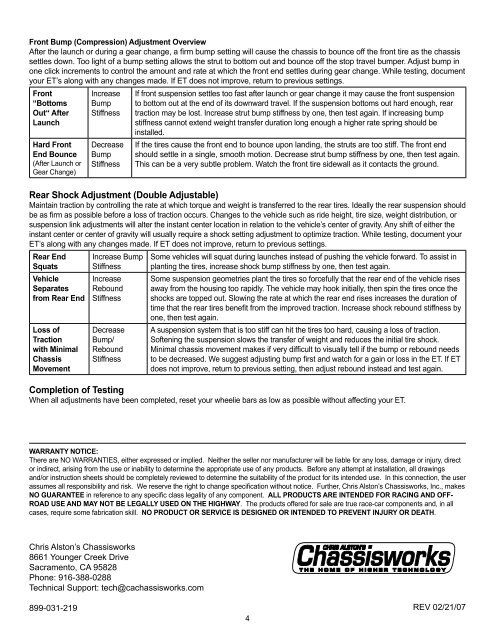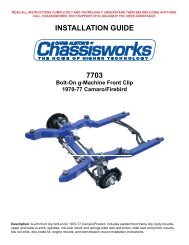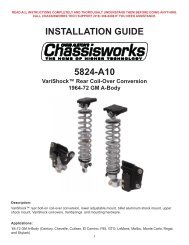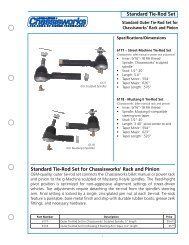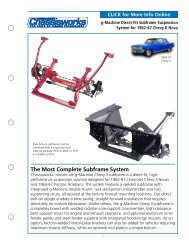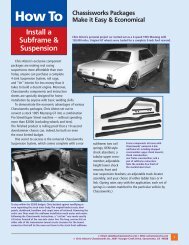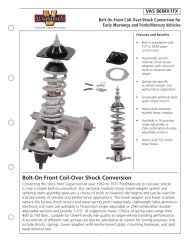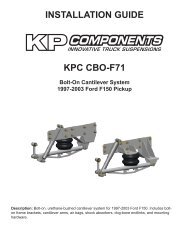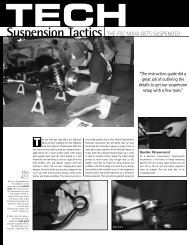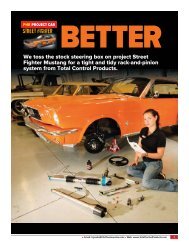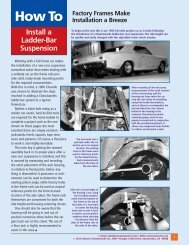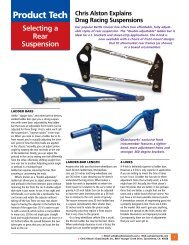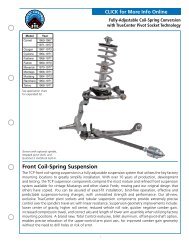VariStrut Adjustment and Tuning Guide - Chris Alston's Chassisworks
VariStrut Adjustment and Tuning Guide - Chris Alston's Chassisworks
VariStrut Adjustment and Tuning Guide - Chris Alston's Chassisworks
You also want an ePaper? Increase the reach of your titles
YUMPU automatically turns print PDFs into web optimized ePapers that Google loves.
Front Bump (Compression) <strong>Adjustment</strong> OverviewAfter the launch or during a gear change, a firm bump setting will cause the chassis to bounce off the front tire as the chassissettles down. Too light of a bump setting allows the strut to bottom out <strong>and</strong> bounce off the stop travel bumper. Adjust bump inone click increments to control the amount <strong>and</strong> rate at which the front end settles during gear change. While testing, documentyour ET’s along with any changes made. If ET does not improve, return to previous settings.Front“BottomsOut“ AfterLaunchHard FrontEnd Bounce(After Launch orGear Change)IncreaseBumpStiffnessDecreaseBumpStiffnessIf front suspension settles too fast after launch or gear change it may cause the front suspensionto bottom out at the end of its downward travel. If the suspension bottoms out hard enough, reartraction may be lost. Increase strut bump stiffness by one, then test again. If increasing bumpstiffness cannot extend weight transfer duration long enough a higher rate spring should beinstalled.If the tires cause the front end to bounce upon l<strong>and</strong>ing, the struts are too stiff. The front endshould settle in a single, smooth motion. Decrease strut bump stiffness by one, then test again.This can be a very subtle problem. Watch the front tire sidewall as it contacts the ground.Rear Shock <strong>Adjustment</strong> (Double Adjustable)Maintain traction by controlling the rate at which torque <strong>and</strong> weight is transferred to the rear tires. Ideally the rear suspension shouldbe as firm as possible before a loss of traction occurs. Changes to the vehicle such as ride height, tire size, weight distribution, orsuspension link adjustments will alter the instant center location in relation to the vehicle’s center of gravity. Any shift of either theinstant center or center of gravity will usually require a shock setting adjustment to optimize traction. While testing, document yourET’s along with any changes made. If ET does not improve, return to previous settings.Rear EndSquatsVehicleSeparatesfrom Rear EndLoss ofTractionwith MinimalChassisMovementIncrease BumpStiffnessIncreaseReboundStiffnessDecreaseBump/ReboundStiffnessSome vehicles will squat during launches instead of pushing the vehicle forward. To assist inplanting the tires, increase shock bump stiffness by one, then test again.Some suspension geometries plant the tires so forcefully that the rear end of the vehicle risesaway from the housing too rapidly. The vehicle may hook initially, then spin the tires once theshocks are topped out. Slowing the rate at which the rear end rises increases the duration oftime that the rear tires benefit from the improved traction. Increase shock rebound stiffness byone, then test again.A suspension system that is too stiff can hit the tires too hard, causing a loss of traction.Softening the suspension slows the transfer of weight <strong>and</strong> reduces the initial tire shock.Minimal chassis movement makes if very difficult to visually tell if the bump or rebound needsto be decreased. We suggest adjusting bump first <strong>and</strong> watch for a gain or loss in the ET. If ETdoes not improve, return to previous setting, then adjust rebound instead <strong>and</strong> test again.Completion of TestingWhen all adjustments have been completed, reset your wheelie bars as low as possible without affecting your ET.WARRANTY NOTICE:There are NO WARRANTIES, either expressed or implied. Neither the seller nor manufacturer will be liable for any loss, damage or injury, director indirect, arising from the use or inability to determine the appropriate use of any products. Before any attempt at installation, all drawings<strong>and</strong>/or instruction sheets should be completely reviewed to determine the suitability of the product for its intended use. In this connection, the userassumes all responsibility <strong>and</strong> risk. We reserve the right to change specification without notice. Further, <strong>Chris</strong> Alston’s <strong>Chassisworks</strong>, Inc., makesNO GUARANTEE in reference to any specific class legality of any component. ALL PRODUCTS ARE INTENDED FOR RACING AND OFF-ROAD USE AND MAY NOT BE LEGALLY USED ON THE HIGHWAY. The products offered for sale are true race-car components <strong>and</strong>, in allcases, require some fabrication skill. NO PRODUCT OR SERVICE IS DESIGNED OR INTENDED TO PREVENT INJURY OR DEATH.<strong>Chris</strong> Alston’s <strong>Chassisworks</strong>8661 Younger Creek DriveSacramento, CA 95828Phone: 916-388-0288Technical Support: tech@cachassisworks.com899-031-219 REV 02/21/07


